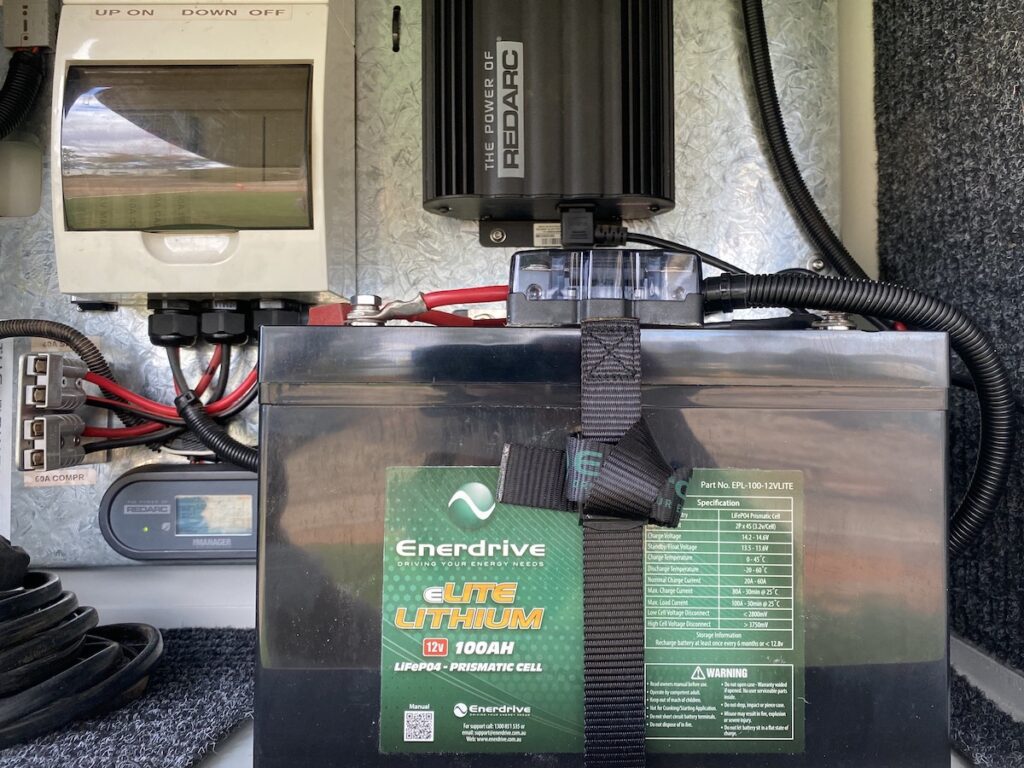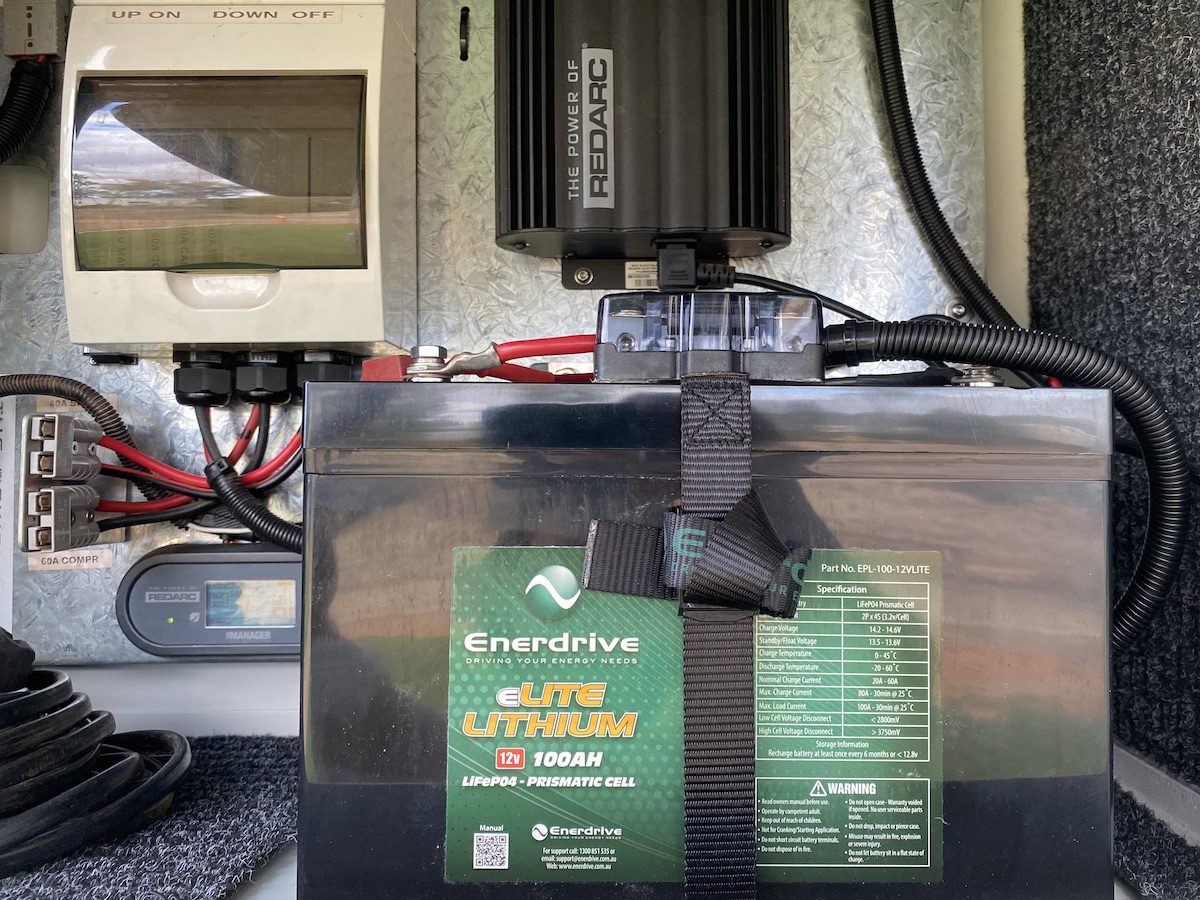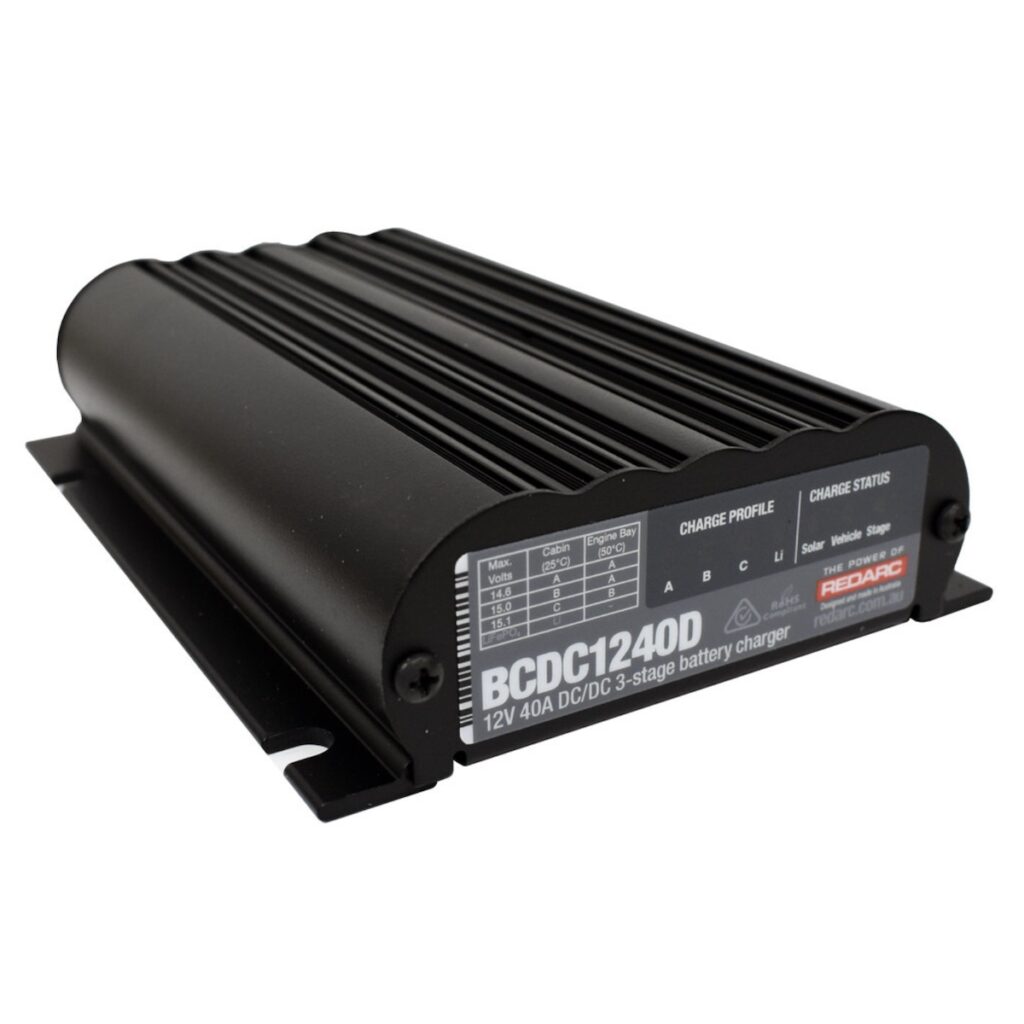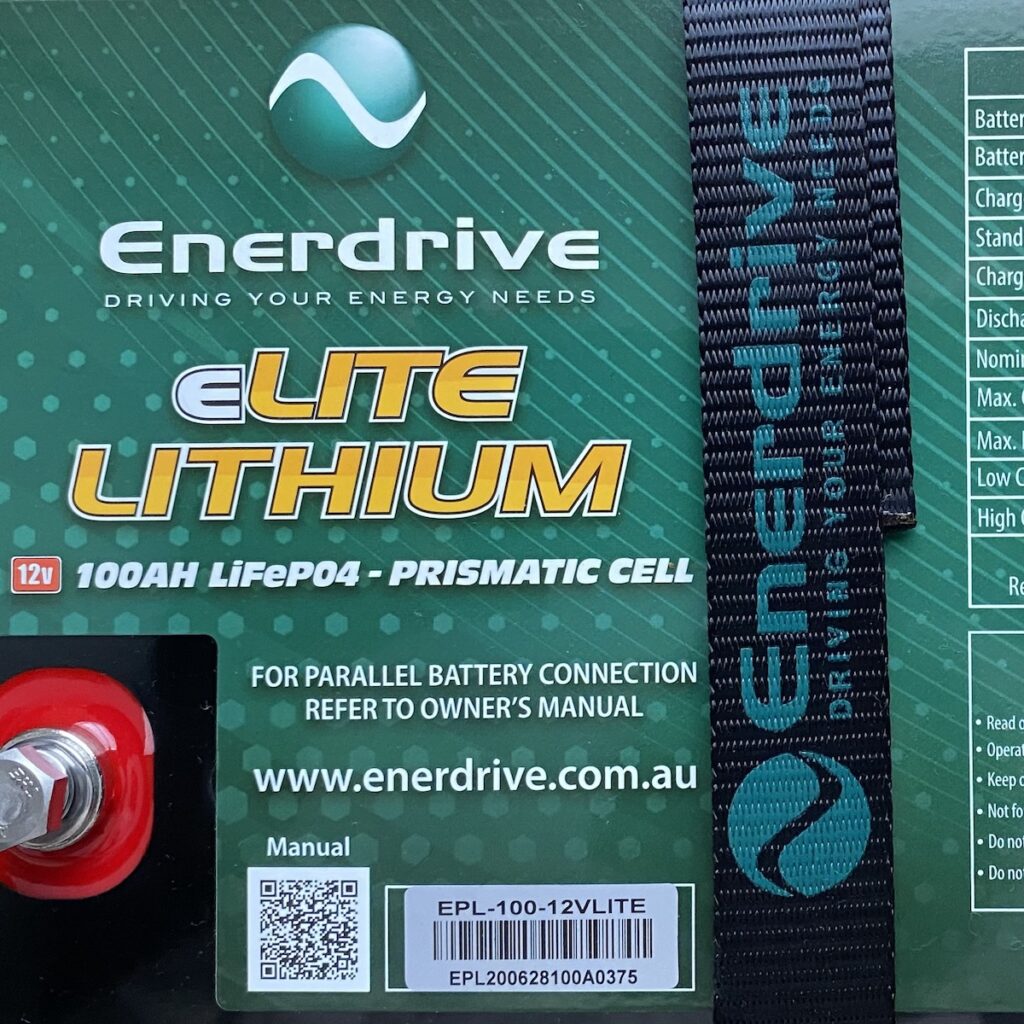Note: This article contains an affiliate link to Outback Equipment. If you click through and make a purchase, we earn a small commission at no extra cost to you.
A deep cycle battery is the beating heart of every dual battery system. Which battery you choose has a big impact on how well your system performs.
When it comes to buying batteries, we tend to focus on the initial purchase price.
AGM is always the cheapest option up-front, but is it cheapest long-term? At first glance, it seems obvious… AGM batteries are way cheaper than Lithium.
But are they really?
Look beyond the initial purchase price and the pendulum swings strongly in favour of Lithium. We’ll explain why.

A Realistic Cost Comparison
AGM and Lithium batteries are deep cycle batteries. They’re the best battery type for a camper, 4WD, RV, caravan, or boat dual battery system.
A deep cycle battery can handle regular discharging and recharging, without being damaged. It’s best for constant loads, rather than the huge current spikes seen by cranking batteries.
Typically, an AGM battery can repeatedly discharge to 50% of capacity. We call this 50% DOD (depth of discharge). Repeated discharges beyond 50% DOD will drastically shorten its lifespan.
So, a 100Ah AGM battery has 50Ah of usable capacity.
A typical Lithium battery can repeatedly discharge to 80% DOD. This means a 100Ah Lithium battery has 80Ah of usable capacity.
Usable Ah:
- AGM battery ➔ 50% DOD. So 100Ah ➔ 50Ah usable
- Lithium battery (typical) ➔ 80% DOD. So 100Ah ➔ 80Ah usable
But if you choose a premium brand Lithium battery, you have the full 100Ah available down to 80% DOD.
How so? Their ratings are nominal… meaning a 100Ah-rated battery for example will actually be bigger (around 125Ah). A 125Ah battery has 100Ah usable @ 80% DOD.
Usable Ah:
- AGM battery ➔ 50% DOD. So 100Ah ➔ 50Ah usable
- Lithium battery (premium) ➔ 80% DOD (actual 125Ah). So 100Ah rating ➔ 100Ah usable
What does this all mean? Well, you can potentially halve the number of batteries…
Say you have a camper with 4 x 100Ah AGM batteries in parallel, for a total of 400Ah. With 50% DOD, you have 200Ah available.
But if you upgrade to Lithium, you can safely install 2 x 100Ah premium brand Lithium batteries for 200Ah available.
We’re comparing premium batteries here, so a typical good quality 100Ah AGM battery will cost around $400 each. That’s a total cost of $1,600.
In contrast, two REDARC 100Ah (or 1 x 200Ah) Lithium batteries will cost around $3,000.
Cost Comparison for 200Ah:
- AGM battery ➔ 100Ah @ $400ea. So 400Ah (200Ah usable) ➔ $1,600
- Lithium battery ➔ 100Ah @ $1,500. So 200Ah (200Ah usable) ➔ $3,000
Lithium’s still nearly double the price of AGMs. But there’s more to this story…
Life Cycles
How long will a deep cycle battery last? Factors like depth of discharge, ambient temperature, discharge current, charging current, and charging voltage affect their life cycles.
Let’s assume both the AGM and Lithium batteries are operating under the same conditions.
If you discharge an AGM battery by 50% every time, you can expect around 600 cycles (one cycle is one discharge plus one recharge).
This means if you discharge it to 50% every day, it’ll last just under 2 years.
In contrast, a REDARC Lithium battery is rated at 5,000 cycles under the same conditions. It’ll last for over 13 years.
Realistically, you’re unlikely to discharge a battery to 50% every single day. Typically expect an AGM battery to last around 3 to 5 years. And if you fork out for a premium brand Lithium battery, expect at least double that.
These life expectancies are a rough guide only. Like anything, it depends on how well you maintain your deep cycle battery. If you:
- Don’t allow it to discharge below its maximum DOD,
- Ensure it’s not discharged at a rate higher than the continuous discharge rate,
- Don’t continually run high loads,
- Use a premium brand in-vehicle charger to ensure it’s charged with the correct charging profile,
- Don’t expose it to wild temperature extremes, and
- Buy a premium brand battery,
…then it should last a long time.
A premium brand in-vehicle charger like this one from REDARC will ensure your battery’s kept in tip-top condition.
Life cycles depend on the depth of discharge (DOD). For example, REDARC’s 100Ah Lithium battery has the following specs:
- Life cycles @ 80% DOD = 2,000
- Life cycles @ 50% DOD = 5,000
- Life cycles @ 20% DOD = 8,000
These specs clearly show how much DOD affects the lifespan of a Lithium battery. The harder you work it, the shorter its lifespan. No surprises there.
Whole-Of-Life Costs… A Clear Winner
So, what about whole-of-life costs? How do AGM and Lithium batteries compare?
In our earlier example, 400Ah of AGM batteries cost $1,600 with around 600 life cycles @ 50% DOD. Equivalent Lithium batteries cost $3,000 with around 5,000 life cycles @ 50% DOD.
This equates to:
- $2.67 per cycle for AGM, and
- $0.60 per cycle for Lithium.
Even if we used cheap AGM batteries at say $250 each, the AGMs will still be $1.67 per cycle.
For 200Ah usable capacity:
- Premium AGM ➔ $1,600 @ 600 cycles ➔ $2.67 per cycle
- Cheap AGM ➔ $1,000 @ 600 cycles ➔ $1.67 per cycle
- Premium Lithium ➔ $3,000 @ 5,000 cycles ➔ $0.60 per cycle
(One cycle = One discharge + one recharge)
This is why Lithium batteries make sense. They are quite simply, way cheaper in the long run… 3 to 6 times cheaper, in fact!
Of course, how much you discharge the batteries, how often you use them, the rate of charge and discharge, plus a range of other factors will affect the cost per cycle.
But no matter how you slice and dice it, a Lithium battery is a cheaper option in the long run.
Now we’ve shown you that premium quality Lithium batteries are worth the extra upfront cost, it’s time for a word of warning…
Not All Lithium Batteries Are the Same
The local market is flooded with cheap Chinese Lithium batteries. Buyer beware!
Good to premium quality 100Ah Lithium batteries are around $1,000 – $1,500. But some of the cheapies are under $350. How are they so cheap?
It seems less reputable Lithium battery manufacturers have all sorts of inventive ways to scam the buyer. As always, you get what you pay for.
Sub-standard Lithium cells, cheap circuit boards, dodgy internal BMS’s, undersized wiring, bad internal connections… the list goes on. There are even cases where manufacturers leave out cells to save money. So your supposed 100Ah is actually 90Ah or less.
Often their specs look as good if not better than the premium Lithium batteries. (That by the way, should be a major red flag). Look closely though and most times they cherry-pick.
Here’s an example.
Premium brands quote:
- Continuous Discharge Current, and
- Maximum Discharge Current.
These two specs are quite different. However, the cheap brands simply take the highest figure and call it “Discharge Current”.
Yes, you can potentially run continuous loads of 100A. But you’ll drastically reduce the battery’s lifespan. And given the cheap batteries are the ones most likely to have undersized internal cabling, don’t be surprised if it shorts internally.
Not all Lithium batteries are the same… not by a long shot.
Another common tactic is mis-quoting battery capacity. As we’ve seen, premium brands tend to quote usable capacity. So, a 100Ah battery can deliver the full 100Ah down to 80% DOD. But a cheap Lithium battery will only deliver 80Ah… if that.
I understand not everyone can pay premium prices for premium batteries. And it depends on what you need it for. A cheap Lithium battery might be fine for occasional use.
Just don’t expect it to perform the same as a premium brand Lithium deep cycle battery.
Go here for more How-To Guides and tips.
Related Resources: Download Excel versions of our Cable Calculators from our Free Resources page
+
a bonus Voltage Drop Calculator.
Any questions or comments? Go to the Comments below or join us on Pinterest, Facebook or YouTube.
Any errors or omissions are mine alone.



